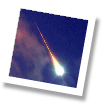Meteor science - general explanations
Observations of meteors Mostly amateur astronomers dominate the meteor science of today. They are the people, who gather and evaluate most observation data. Out of their experiences new ideas crystallized, which actually changed highly the meteor science over the last years. However one observes here above all normal, faint meteors and thus the pertinent meteor streams, which are produced by the comets, which are vagabonding in the planetary system. AIt were also the amateurs, who built the first camera systems, in order to document meteors by video monitoring. This video technology is today the fundamental tool, with which one controls and documents dynamic changes of the meteor rates of a daily base. Therefore at present a worldwide meteor network is formed which is based on this technology.
The Fireball Network There is also a professionally operating Fireball Network in Europe (the European Fireball Network – EFN), which is trying to document simultaneously (mainly by photographic methods) the more infrequent large meteors, in order to get the ability to calculate their trajectory with these data. In the process the scientists are aiming for a preferably exact determination of the trajectory of those spectacular meteor phenomena in the atmosphere. Additionally with that intention they are able to backtrack the orbit of the meteoroid back into the interplanetary space. A further aspect of this methodology is also showing promise. One wants to use the infrequent opportunity to document a current meteorite fall in that way, that such a calculation comes to a delimited drop area, in order to get scientifically valuable samples from the solar system
Large meteor phenomena In principle on average approx. four bright fireball events are sighted above an area like Germany in each week. Large fire meteors or bolides you can observe approximately twice per month throughout Europe. However these events are to be seen rather only very local then, and thereby appear to an observer even so rarely. Also many people miss out their whole life long, since they never were at the correct time of day at the correct place. A detonating meteor is a still much more rare event and occurs probably only about four times in one year across an area like the European Union. Possibly it comes thereby to a meteorite event once to twice in the year. These cases however are not always noticed or the meteorite, which is fallen, obviously remains afterwards undiscovered. Because in the long run it remains rather dependent on chance also in closely populated Europe, that the meteorite hits somewhere in the proximity of a human.
It happens, but when? All these data certainly fluctuate over a longer period of time. On one hand there are seasonal fluctuations, let it be the unsettled European weather or the different lengths of day and night, whereby permanently new observation conditions will result. On the other hand there are real documented variances of the invasion rate of meteoroid objects. The comet-originated material alone (which comes from the meteor streams) is showing manifestly the annual variances. These meteor streams are changing in a more or less significant mode during decades and in doing so they generate different quantity of normal or large meteors. Aside there are also the sporadic meteors, which one can rather rarely observe in the sky. These types of meteors generate a mentionable number of spectacular meteor appearances, because this group is containing all meteoroids, from which we get asteroid-originated material on Earth. Indeed their rates are variable, but there are no periodical fluctuations.
Types of meteors and their dfferences For large and bright meteors there is taxonomy of fireball types. Their originators can be divided into three clearly distinguishable groups of meteor types. Those named as Type I are these with the highest material density and the most stable structure. Nearly all meteorite falls were introduced by this type of fireball. Meteors of type II are of less density and stability. One assigns the fragile and rather carbonaceous meteoroids to this type. The meteors belonging to type III are extreme fragile and feature a very low density. This is the group of comet-like meteoroids Meteors can be seen in very different ways at the sky. In principle there are three ascending brightness gradations – meteor, fireball, bolide –, which in this order show likewise a more voluminous appearance. Meteors are often observed, which flash, flicker, or even extinguish for short periods, and then to continue awhile. There are normal meteors, which are flaring up for a short time and are being seen as a nebular or line-shaped object. Spectacular meteors on the other hand move unhurriedly along its trajectory nearly across the entire sky, with a voluminous globe in the front section and a long fire tail behind it. Meteors at the sky can suddenly become bright like the moon or the sun and then disappear as suddenly as they came. There are colourful occurrences and others with a long plasma trail of the trajectory at night or a line-like dust trail by day. Both phenomena, the plasma trail and the dust trail, will be blown over bit by bit. Large meteors potentially can split up into several luminous spots. There are even meteors, which you notice also acoustically at the same time with the light appearance. Detonating meteors can even terribly frighten a surprised witness, because they are extremely loud and widely audible.. | ||||
 | ||||
Meteoric Science

![]()
![]()


![]()






